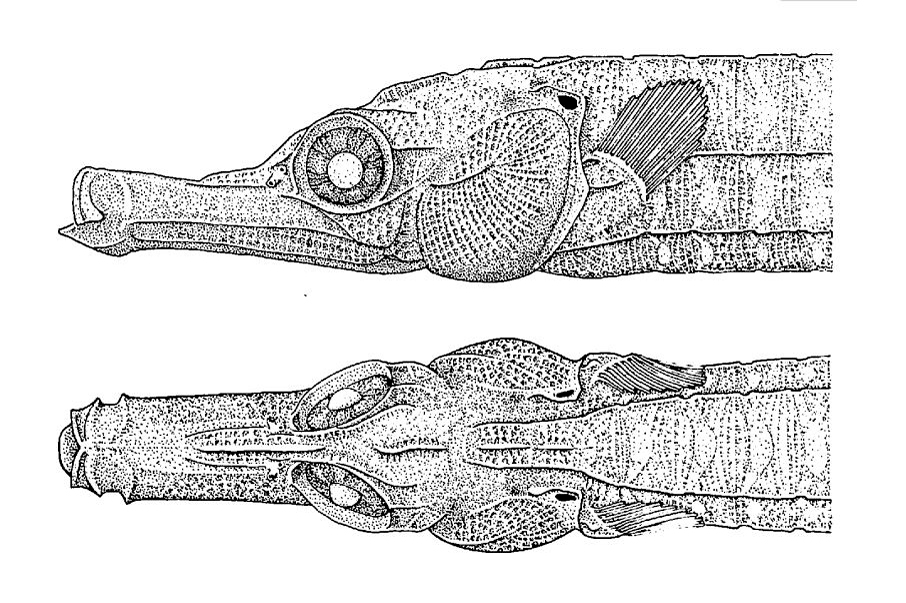Gibbs' Pipefish, Festucalex gibbsi Dawson 1977

Illustration of the head of the holotype of Gibbs' Pipefish, Festucalex gibbsi, BMNH 1975.10.9.7, 60-mm SL male, from Queensland. Source: after Fig. 12 (bottom) in Dawson (1977) Bulletin of Marine Science 27(4). License: All rights reserved
A small brownish tropical pipefish with a pale snout, often an iridescent white bar below the opercular ridge, indistinct bars between the rings along the upper sides of the trunk and several faint pale bars along the lower part of the trunk. The tail is brownish with faint bars between the rings,and a brownish caudal fin with a pale margin.
Gibbs' Pipefish, Festucalex gibbsi Dawson 1977
More Info
|
Distribution |
Great Barrier Reef, Queensland, West Papua, and the Chesterfield Islands, New Caledonia. Inhabits open rubble and soft-bottom areas in depths of 20-91 m. |
|
Features |
Dorsal fin 21-24; Pectoral fin 13-14; Body rings 18 + 32-33 = 50-51; Trunk rings 18; subdorsal rings 1.5- 2.0 + 3.5-4.25 = 5.5-6.25; subdorsal trunk rings 1.5-2.0; lateral trunk ridge ends on 2nd-3rd tail ring. Median dorsal snout ridge entire, vestigial or obsolete in front, originating near middle of snout, mainly low but arching upward just before nostrils; lateral snout ridge obsolete; postorbital ridge low; short supraopercular ridge present in holotype, vestigial or absent in other material; opercular ridge low, not protruding distinctly laterally; pectoral-fin base with distinct superior and inferior ridges; prenuchal and nuchal ridges low or vestigial, frontal ridge somewhat higher. Dermal flaps absent from body; frontal ridge margined by a low flap; paratype with slender simple flap dorsolaterad above middle of operc1e. Dorsal surface of holotype somewhat depressed between superior trunk ridges and with shallow angular notches between rings, paratype nearly flat with slight indentations between rings; superior and inferior tail ridges somewhat elevated with sides and back depressed between, ridges little indented between rings; posterior angles of tail rings produced to a minute point last 2-3 tail rings without modified ridges; ventral surface of trunk distinctly V-shaped, median ridge prominent. |
|
Size |
Attains about 100 mm TL. |
|
Colour |
Brownish with a pale snout, tan and brown blotches on head, often an iridescent white bar below the opercular ridge; trunk with indistinct bars and small tan spots between rings, lower side and underside brownish with diffuse pale bars (about one ring wide) on 2nd, 6th, 11th and 15th rings. Back and sides of tail brownish with faint bars between rings, often minute pale spots ringing each scutella, underside of tail mainly brown, pouch folds pale with minute pale flecks, caudal fin brownish with pale margin. |
|
Biology |
Males brood the eggs in a pouch on the underside of the tail. |
|
Etymology |
The species is named gibbsi in recognition of P. E. Gibbs, collector of the type-material. |
|
Species Citation |
Festucalex gibbsi Dawson 1977, Bull. Mar. Sci. 27(4): 633, figs 11-12. Type locality: north QLD, 22m [14°37´S, 145°28´E]. |
|
Author |
Bray, D.J. & Thompson, V.J. 2017 |
|
Resources |
Gibbs' Pipefish, Festucalex gibbsi Dawson 1977
References
Allen, G.R. & Erdmann, M.V. 2015. Festucalex rufus, a new species of pipefish (Syngnathidae) from Milne Bay Province, Papua New Guinea. aqua, International Journal of Ichthyology 21(1): 47-51.
Allen, G.R. & Erdmann, M.V. 2012. Reef fishes of the East Indies. Perth : Tropical Reef Research 3 vols, 1260 pp.
Dawson, C.E. 1977. Synopsis of syngnathine pipefishes usually referred to the genus Ichthyocampus Kaup, with description of new genera and species. Bulletin of Marine Science 27(4): 595-650 figs 1-19
Dawson, C.E. 1985. Indo-Pacific Pipefishes (Red Sea to the Americas). Ocean Springs (Mississippi) : Gulf Coast Research Laboratory 230 pp. 293 figs pl. 1.
Kuiter, R.H. 2000. Seahorses, Pipefishes and Their Relatives. Chorleywood, UK : TMC Publishing 240 pp.
Kuiter, R.H. 2009. Seahorses and their relatives. Seaford, Australia : Aquatic Photographics pp. 331.
Paulus, T. 1999. Family Syngnathidae. pp. 2264-2276 in Carpenter, K.E. & Niem, T.H. (eds). The Living Marine Resources of the Western Central Pacific. FAO Species Identification Guide for Fisheries Purposes. Rome : FAO Vol. 4 pp. 2069-2790.


